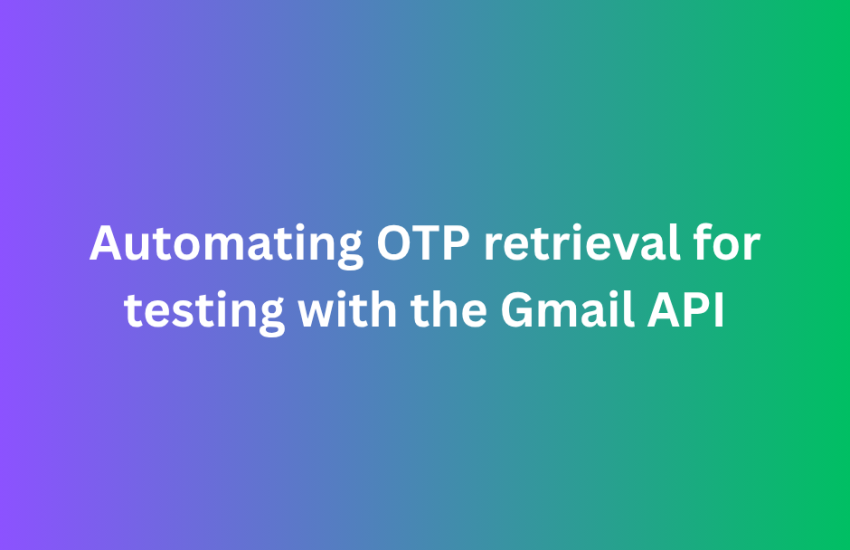I had to encounter a situation where I needed to do testing or automate a task but there was multi-factor authentication in place and I needed an automated way to retrieve OTPs for internal testing reasons. This is how you can handle that situation using the Gmail API — which is free to use for standard accounts and integrates well with Selenium test scripts.
Why use the Gmail API for automated testing
When you’re writing end-to-end tests that involve accounts protected by OTPs, manually retrieving codes breaks automation. The Gmail API provides a programmatic, auditable way to read test emails so your automation can continue, provided you follow best practices: use test accounts or domain-delegated service accounts, use OAuth properly.
High-level approach
- Create dedicated test email accounts (or use a G Suite / Google Workspace test domain). Never use real users’ accounts for automated OTP retrieval.
- Use OAuth2 or a service account with domain-wide delegation (for Workspace) to grant read access to the test inboxes — no password scraping, no bypassing MFA.
- Implement a small helper module that uses the Gmail API to search recent emails for the OTP message, parse the message body, extract the code, and return it to your test flow.
- Integrate with your Selenium tests so the test waits/polls the helper for the OTP, then proceeds to enter it into the UI.
- Audit and rotate credentials regularly and restrict scopes to https://www.googleapis.com/auth/gmail.readonly only.
Setup Steps
- Enable Gmail API on Google Cloud Console.
- Download your OAuth credentials JSON (credentials.json).
- Place it in your project and define paths for:
- CREDENTIALS_FILE → path to your OAuth client JSON
- TOKEN_FILE → token file (created automatically after first login)
- Install dependencies:pip install google-auth google-auth-oauthlib google-auth-httplib2 google-api-python-client beautifulsoup4 lxml
- Run the script once manually — a browser window will open for authorization. A token file will be created and reused later for automated runs.
Key Idea
The approach is simple:
- Use Gmail API (with OAuth) to read your own test inbox.
- Query the inbox for recent messages from a specific sender and subject.
- Extract the OTP using regex patterns.
- Return the OTP to your test framework (e.g., Selenium).
This ensures secure and auditable access — no “bypassing” MFA — and allows you to test login workflows end-to-end.
Full Working Python Script
import os
import re
import base64
import datetime
from bs4 import BeautifulSoup
from google.auth.transport.requests import Request
from google.oauth2.credentials import Credentials
from google_auth_oauthlib.flow import InstalledAppFlow
from googleapiclient.discovery import build
# Define constants
SCOPES = ['https://www.googleapis.com/auth/gmail.readonly']
CREDENTIALS_FILE = 'credentials.json'
TOKEN_FILE = 'token.json' # Created automatically after first OAuth run
# Regex patterns for OTPs (adjust as needed)
OTP_PATTERNS = [
r'\b(\d{6})\b', # six digits
r'\b(\d{4})\b', # four digits
r'\b(\d{5})\b', # five digits
r'code[:\s]*([0-9]{4,8})', # "code: 123456"
r'one[-\s]?time[-\s]?password[:\s]*([0-9]{4,8})',
]# Step 1: Authenticate and create Gmail API service
def get_gmail_service():
creds = None
if os.path.exists(TOKEN_FILE):
creds = Credentials.from_authorized_user_file(TOKEN_FILE, SCOPES)
if not creds or not creds.valid:
if creds and creds.expired and creds.refresh_token:
creds.refresh(Request())
else:
flow = InstalledAppFlow.from_client_secrets_file(CREDENTIALS_FILE, SCOPES)
creds = flow.run_local_server(port=0)
with open(TOKEN_FILE, 'w') as token:
token.write(creds.to_json())
return build('gmail', 'v1', credentials=creds)# Step 2: Gmail query helpers
def search_messages(service, query, max_results=1):
response = service.users().messages().list(userId='me', q=query, maxResults=max_results).execute()
return response.get('messages', [])
def get_message(service, msg_id):
return service.users().messages().get(userId='me', id=msg_id, format='full').execute()# Step 3: Extract and decode email body
def extract_text_from_part(part):
data = part.get('body', {}).get('data')
if not data:
return ''
return base64.urlsafe_b64decode(data.encode('ASCII')).decode('utf-8', errors='ignore')
def get_message_body(msg):
payload = msg.get('payload', {})
mime_type = payload.get('mimeType', '')
if mime_type == 'text/plain':
return extract_text_from_part(payload)
if mime_type == 'text/html':
html = extract_text_from_part(payload)
return BeautifulSoup(html, 'lxml').get_text(separator='\n')
texts = []
for part in payload.get('parts', []):
ptype = part.get('mimeType', '')
if ptype == 'text/plain':
texts.append(extract_text_from_part(part))
elif ptype == 'text/html':
html = extract_text_from_part(part)
texts.append(BeautifulSoup(html, 'lxml').get_text(separator='\n'))
return '\n'.join(texts)# Step 4: Regex-based OTP finder
def find_otp_in_text(text):
for pat in OTP_PATTERNS:
m = re.search(pat, text, re.IGNORECASE)
if m:
return m.group(1)
return None
def pretty_headers(headers):
return {h['name']: h['value'] for h in headers}# Step 5: Main OTP extractor
def hs_otp():
service = get_gmail_service()
today_date = datetime.datetime.now().strftime("%Y/%m/%d")
specific_sender = "no-reply@xyz.com" # Replace with sender
specific_subject = "Your OTP Code" # Replace with subject
query = f'from:{specific_sender} subject:"{specific_subject}" after:{today_date}'
msgs = search_messages(service, query)
if not msgs:
print("No emails found from today matching the query.")
return
msg = get_message(service, msgs[0]['id'])
headers = pretty_headers(msg.get('payload', {}).get('headers', []))
body = get_message_body(msg)
otp = find_otp_in_text(body)
if otp:
print(f"Extracted OTP: {otp}")
return otp
else:
print("No OTP found in this email.")
print(body[:500])
return None Function Summary
| Function | Purpose |
|---|---|
| get_gmail_service() | Authenticates via OAuth2 and returns a Gmail API client. Token is saved for reuse. |
| search_messages() | Queries inbox using Gmail search operators (from, subject, after, etc.). |
| get_message() | Fetches a full email by message ID. |
| get_message_body() | Decodes and extracts plain text or HTML content from an email. |
| find_otp_in_text() | Uses regex to locate OTP patterns (4–8 digits or “code: xxxx”). |
| hs_otp() | End-to-end helper that searches recent messages, parses them, and prints or returns the OTP. |




